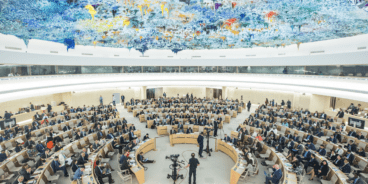
UN Targets Libya with Pinpoint Accuracy
This article written by Prof. the Hon. Gareth Evans was originally published in Project Syndicate.
There is only one justification for military intervention: protecting people from being murdered by Gaddafi.
The international military intervention in Libya is not about bombing for democracy or Muammar Gaddafi’s head – let alone keeping oil prices down or profits up. Legally, morally, politically and militarily it has only one justification: protecting the country’s people from the kind of murderous harm that Gaddafi inflicted on unarmed protesters four weeks ago, has continued to apply to those who oppose him in the areas he controls, and has promised to inflict on anyone against him should his forces recapture Benghazi and other rebel ground. And when that job is done, the military intervention will be done. Any regime change is for the Libyan people themselves to achieve.
These very basic points should not need to be rearticulated and reargued, but they do. Despite the best efforts of US President Barack Obama, UN Secretary-General Ban Ki-moon, our own Prime Minister and Foreign Minister, and others who have stayed focused and consistent, there are voices now capturing media attention – from the right, the left and the simply muddled – who are beginning to drown, or at least confuse, the basic message.
US senators John McCain and Joe Lieberman, for example, have said that the aim must be not just to protect civilians but to make sure Gaddafi goes. British Defence Secretary Liam Fox has suggested Gaddafi could be targeted. And from the other side, many commentators, anxiously or cynically according to taste, have drawn parallels with Iraq and other misuses of Western military power in the past. Many others talk of being drawn inexorably into another open-ended Afghanistan quagmire.
To clarify the issues, the best place to start is with the two UN Security Council resolutions. The first, resolution 1970 of February 26, invoked ”the Libyan authorities’ responsibility to protect its population”, condemned its violence against civilians, demanded that this stop and sought to concentrate Gaddafi’s mind by applying targeted sanctions, an arms embargo and the threat of International Criminal Court prosecution for crimes against humanity.
The follow up, resolution 1973 a week ago, deplored the failure to comply with the first, reasserted a determination to ensure the protection of civilians, called for an immediate ceasefire and a complete end to violent attacks against and abuses of civilians, and then, in a historic first, explicitly authorised military intervention by member states to achieve these objectives.
Coercive military action was allowed to take two forms: ”all necessary measures” to enforce a no-fly zone, and ”all necessary measures . . . to protect civilians and civilian populated areas under threat of attack”. But boots on the ground – ”a foreign occupation force” – were expressly excluded.
The language of these resolutions, in prescribing both the scope and limits of what should be done, could hardly be clearer. In the case of enforcing the no-fly zone, what is clearly allowed is the destruction of any Gaddafi jet or helicopter that takes off, or of any Libyan anti-aircraft batteries or missile launch sites, or the disabling of any airstrip. And for the wider civilian protection mandate, what is clearly allowed is airborne action to knock out tanks or troop columns advancing on Benghazi or other rebel-held towns, and – should they exist – concentrations of forces within those areas that pose a direct threat to Gaddafi’s opponents.
Some questions do arise at the margins. Is it within the scope of the no-fly zone to take out command and control centres that might direct aircraft? Is it legitimate to kill regime forces fleeing a protected area, or in some other way posing no obvious or imminent threat to civilians? Should an absolute line be drawn against any otherwise legitimate action against Gaddafi’s forces that would be likely to put innocent civilians at risk?
But beyond these kinds of questions, room for debate runs out. Military action expressly designed to kill Gaddafi or force him into exile, to ensure rebel victory in a civil war, or to achieve a more open and responsive system of government in Libya is simply not permissible under the explicit legal terms of UN resolution 1973. Nor is it permissible under the moral first principles of the ”responsibility to protect” doctrine – which was unanimously endorsed by the world community in 2005 to try to end once and for all Cambodia, Rwanda and Bosnia-type mass-atrocity crimes. It is true that one or more of these results might, conceivably, be the effect of permissible military action, but they cannot be its objective.
It also follows from these legal and moral first principles that once there are reasonable grounds for confidence that the threat to civilian populations has been removed or neutralised (as seems now to be largely the case, at least in the east), the military action should cease. But, of course, a close watching brief should be maintained so that action can be quickly reinstated if circumstances warrant. Offshore-based airborne action, with a sharply defined and limited objective, is much less susceptible to the kind of mission-creep and quagmire problems that often beset intervening ground forces, especially ones with a confused mandate as in Afghanistan.
As the situation in Libya and the wider Middle East unfolds, there are bound to be further acute dilemmas for policymakers, not least in responding effectively to continuing repression in Tripoli, or the similar situations in Bahrain and Yemen. Mustering the cross-cultural political will to give real and consistent protection to civilians is always going to be difficult. But, at least in Libya, a hugely important precedent has been set. The Security Council has written exactly the right script – it’s just a matter now of following it.
Related Content


